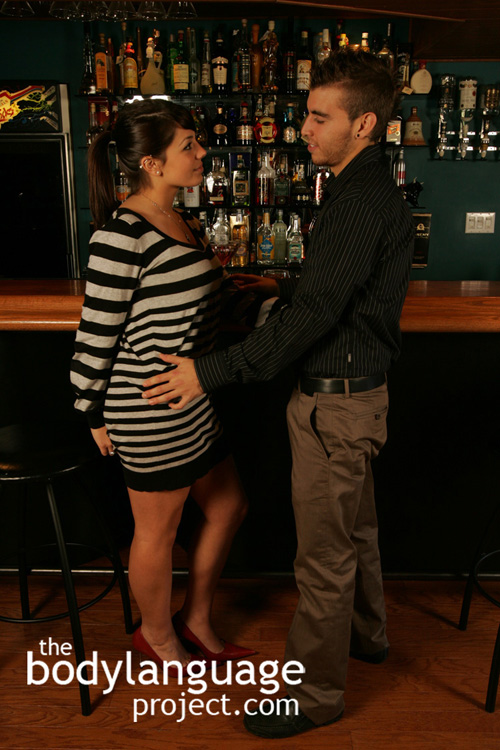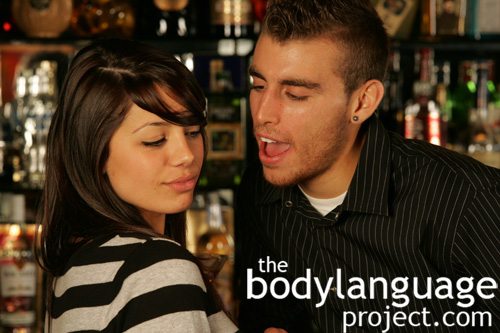Body Language of Strutting
Synonym(s): Swagger.
Description: A careless, slow, deliberate gait with shoulders back, chest out, head up, as if swimming through the air. The upper body moves back and forth confidently.
In One Sentence: Strutting is a type of gait displaying supreme confidence.
How To Use it: Use strutting or swagger to show others that good things happen to you and that you are able to control the results in your life. This works well in any context but if done too conspicuously will appear as smug. When using the cue, be sure that it can be backed up with other confident demeanor including a relaxed and slow speech pattern, proper gesticulation and so forth. President Obama is a great example of walking with swagger and he also backs it up with swagger in his speech and gesture. In dating, swagger is highly regarded as it is in business.
Context: a) Dating b) Business.
Verbal Translation: “I’m confident and in control. I walk with my head up, shoulders back, chest puffed out so that others take note of my dominance and show me respect and admiration.”
Variant: See Gait or Walking Styles.
Cue In Action: a) He walked by the girls in full strut, his chest puffed out trying to appear larger than he actually was. b) The boss was confident and this was easy to see. His gait was smooth, deliberate, and effortless. He walked with his head held high, back strait and arms moving smoothly with each stride.
Meaning and/or Motivation: High ranking officials such as presidents and high level business men habitually strut. A swagger occurs while walking and is a display of confidence, dominance and usually sex appeal. Men are said to strut when trying to appear masculine in the eye of women. Women can also strut, but it’s not as typical as it is for men.
If someone is going out of their way to strut, he is likely trying to impress others but might not have the gull to back it up. True strutting appears effortlessly and is backed by real life accomplishments.
Cue Cluster: The strut is a collection of cues in cluster. Head high, back straight but fluid, arms in motion and chest puffed out. Watch for additional cues to verify the honesty of the strut. Those with confidence will also carry open postures such as arms uncrossed and out of pockets, make and hold eye contact easily, touch people freely when appropriate, maintain open postures, gesticulate when appropriate and so forth.
Body Language Category: Arrogance or arrogant body language, Authoritative body language, Confident body language, Dominant body language, Expansive movements, Gravity defying body language, High confidence body language, Indicators of sexual interest (IOsI), Leadership body language, Open body language, Threat displays, Up nonverbals.
Resources:
Atkinson AP, Dittrich WH, Gemmell AJ, Young AW (2004) Emotion perception
from dynamic and static body expressions in point-light and full-light displays.
Perception 33: 717–746. doi: 10.1068/p5096.
Crane, Elizabeth ; Gross, M. Effort-Shape Characteristics of Emotion-Related Body Movement. Journal of Nonverbal Behavior. 2013. 37(2): 91-105.
de Meijer M (1989) The contribution of general features of body movement to
the attribution of emotions. J Nonverbal Behav 13: 247–268. doi: 10.1007/
BF00990296.
Eisenberg, P. Expressive movements related to feelings of dominance. Archives of Psychology, 1937, No. 211. Ekman, P. Universals and cultural differences in facial expression of emotion. In J. K. Cole (Ed.),
Eisenberg, Philip ; Reichline, Philipb. Judging Expressive Movement: II. Judgments of Dominance-Feeling from Motion Pictures of Gait. The Journal of Social Psychology. 1939. 10(3): 345-357.
Eisenberg, Philip ; Reichline, Philipb. Judging Expressive Movement: II. Judgments of Dominance-Feeling from
Johnson, Kerri L ; Gill, Simone ; Reichman, Victoria ; Tassinary, Louis G. Swagger, sway, and sexuality: Judging sexual orientation from body motion and morphology. Journal of personality and social psychology. 2007. 93(3): 321-34.
Ginsburg, H. J. Playground as laboratory: Naturalistic studies of appeasement, altruism, and the omega child. In D. R. Omark, F. F. Strayer, & D. G. Freedman (Eds.), Dominance relations: An ethological view of human conflict and social interaction. New York: Garland, 1980.
Gorkan Ahmetoglu, Viren Swami. Do Women Prefer “Nice Guys?” The Effect Of Male Dominance Behavior On Women’s Ratings. Social Behavior And Personality, 2012; 40(4), 667-672.
http://bodylanguageproject.com/articles/how-to-significantly-increase-male-attractiveness-with-simple-body-language-nice-guys-finish-last-once-again/
Gross, M Melissa ; Crane, Elizabeth A ; Fredrickson, Barbara L. Effort-Shape and kinematic assessment of bodily expression of emotion during gait. Human movement science. 2012. 31(1): 202-21.
Janssen, Daniel ; Schöllhorn, Wolfgang ; Lubienetzki, Jessica ; Fölling, Karina ; Kokenge, Henrike ; Davids, Keith. Recognition of Emotions in Gait Patterns by Means of Artificial Neural Nets. Journal of Nonverbal Behavior. 2008. 32(2): 79-92.
Jessica L. Tracy and David Matsumoto. The Spontaneous Expression Of Pride And Shame: Evidence For Biologically Innate Nonverbal Displays. 2008; 105 (33) 11655-11660.
http://bodylanguageproject.com/articles/universal-expressions-of-pride-and-shame/
Johnson, Kerri L ; Tassinary, Louis G. Perceiving sex directly and indirectly: meaning in motion and morphology. Psychological science. 2005. 16(11): 890-7.
Kito, Tomonori ; Yoneda, Tsugutake. Dominance of gait cycle duration in casual walking. Human Movement Science. 2006. 25(3): 383-392.
Montepare, Joann ; Zebrowitz, Leslie. A cross-cultural comparison of impressions created by age-related variations in gait. Journal of Nonverbal Behavior. 1993. 17(1): 55-68.
Montepare, J. M., Goldstien, S. B., & Clausen, A. (1987). The identification of emotions from gait information. Journal of Nonverbal Behavior, 11, 33–42.
Mastow, A. H. The role of dominance in the social and sexual behavior of infra-human primates: I. Observations at Vilas Park Zoo. Pedagogical Seminary and Journal of Genetic” Psychology, 1936, 48, 261-277.
Maslow, A.H. Dominance-feeling, behavior, and status. Psychological Review, 1937, 44, 404-429.
Mehrabian, A. Influence of attitudes from the posture, orientation and distance of a communicator. Journal of Consulting and Clinical Psychology, t968, 32, 296-308.
Mehrabian, Albert Deese, James (editor). Significance of posture and position in the communication of attitude and status relationships. Psychological Bulletin. 1969. 71(5): 359-372.
Moore, Monica. Courtship Signaling and Adolescents: Girls Just Wanna Have Fun. Journal of Sex Research. 1995. 32(4): 319-328.
http://bodylanguageproject.com/articles/girls-just-want-to-have-fun-the-origins-of-courtship-cues-in-girls-and-women/
Martens, Jason P.; Jessica L. Tracy and Azim F. Shariff. Status signals: Adaptive
benefits of displaying and observing the nonverbal expressions of pride and shame, Cognition & Emotion. 2012. 26(3): 390-406. DOI: 10.1080/02699931.2011.645281
http://bodylanguageproject.com/articles/significant-nonverbal-expression-pride-shame-body-language-detailed-examination-origin-function/
Montepare, Joann ; Zebrowitz, Leslie. A cross-cultural comparison of impressions created by age-related variations in gait. Journal of Nonverbal Behavior. 1993. 17(1): 55-68.
Montepare, Joann ; Goldstein, Sabra ; Clausen, Annmarie. The identification of emotions from gait information. Journal of Nonverbal Behavior. 1987. 11(1): 33-42.
Montepare, J. M., & Zebrowitz-McArthur, L. (1988). Impressions of people created by age-related qualities of their gaits. Journal of Personality and Social Psychology, 55(4), 547–556. http://dx.doi.org/10.1037/ 0022-3514.55.4.547.
Prasad, S., & Shiffrar, M. (2009). Viewpoint and the recognition of people from their movements. Journal of Experimental Psychology – Human Perception and Performance, 35(1), 39–49. http://dx.doi.org/10.1037/A0012728.
Roether, C. L., Omlor, L., Christensen, A., & Giese, M. A. (2009). Critical features for the perception of emotion from gait. Journal of Vision, 9(6), 1–32. http://dx.doi.org/10.1167/9.6.15.
Schneider, Sabrina ; Christensen, Andrea ; Hau[sz]inger, Florian B. ; Fallgatter, Andreas J. ; Giese, Martin A. ; Ehlis, Ann – Christine. Show me how you walk and I tell you how you feel — A functional near-infrared spectroscopy study on emotion perception based on human gait. Neuroimage. 2014. 85: 380(11).
Van Der Zwan, Rick ; Herbert, Natasha. “I like the way you move”: how hormonal changes across the menstrual cycle affect female perceptions of gait.(Research article)(Report). BMC Research Notes. 2012. 5: 453.
Weisfeld, Glenn E. and Jody M. Beresford. Erectness of Posture as an Indicator of Dominance or Success in Humans. Motivation and Emotion. 1982. 6(2): 113-130.
http://bodylanguageproject.com/articles/body-language-cues-dominance-submission-children/






